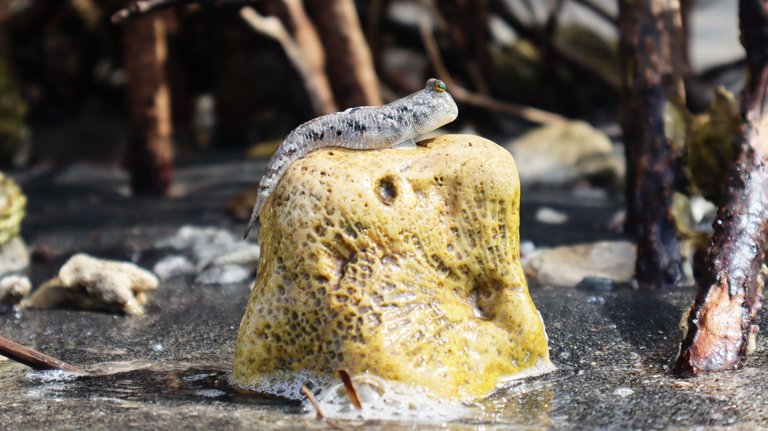These legs, which hang the tree above the water, are of course the first thing that makes this plant look different from other plants. Arched legs that seem to step in all directions above the water surface are known as aerial prop roots, adventitious roots. This must be the first thing that attracts interest.
Second, it grows as thickets or dense trees in estuaries or marshes near the shore, which are the intertidal zone. Here I am at the mouth of a river in a place called Kuta Leuboek, on the northwest coast of Aceh, Sumatra. Rhizophora mangle or red mangroves grow here.
I washed my face and rinsed my mouth with water there, and then found that it was only a little cloudy and not choppy which distinguished the water there from sea water, while the taste was almost no different from sea water. This is perhaps the second thing that really distinguishes this plant from various other plants. While other plants dry up quickly and die in the face of sea water, mangroves have extraordinary adaptability to salty conditions.
On the other hand, if we know the ecological values that mangroves have, I am sure, we will immediately fall in love with them and love them with all our heart. In short, the mangrove or mangal environment is like a nursery for various types of fish and a home for a variety of aquatic species such as crabs, shellfish and others. Mangroves are also home to a variety of wildlife such as birds, monkeys and others to honey bees. And when we look back at the mangrove roots, we are immediately sure, they are a great gift to us. These roots slow down water flow, facilitate sedimentation of the sediment, filter various materials in the water, especially pollutants from various wastes, and improve water quality. With these roots, the mangrove community builds a shoreline protection system, absorbs wave energy, and blocks the speed of the water. There are so many ecological values that mangroves and mangrove areas have, and these are all great gifts.
During my trip to the mangal area on the seashore of Kuta Leubok, I had the opportunity to take pictures of some of the inhabitants of the habitat there. Here they are.
Hermit crabs
Their appearance as a snail or a gastropod should not surprise us because they are indeed hermits, that is, they were not born with that snail shell, they are just hermits inside to protect their fragile exoskeleton. There are two families of hermit crabs that I happened to come across at that time, one is the genus Clibanarius in the family Diogenidae, and the other is the genus Coenobita in the family Coenobitidae.
Clibanarius. As my feet sank into the water where they appeared to be overwhelmingly there, I felt something like pinching the skin of my feet! They are omnivores. Does it think my skin is prey because it's also a scavenging carrion? I picked it up and placed it on the small stone, and noticed that in just a moment it had attempted to move back into the water. It does not appear to be able to survive long out of water.
Coenobita. Unlike the Clibanarius, this Hermit crab carries water in the gastropod so they can last longer out of water.
They are gathering.
A competition for shells seems to be taking place here.
Mudskippers
Those eyes protruded upwards from his flat head. The side fins are closer to the bottom of the body, and really look like legs that allow it to move around, jump over the mud, sometimes even climb. This ability to live outside and in water is the most attractive feature of the amphibian fish that is in the family Oxudercidae. It lives in burrows in intertidal habitats. It usually looks very active when out of water. I could take these pictures at that time only for some reason I didn't know, it didn't move away when I approached it, sometimes it even seemed like deliberately getting close. So far, I think, this is the single most unique experience for me with Mudskippers.
Mangrove oyster
The mangrove oyster or Crassostrea tulipa appears to stick to the bark of the mangrove roots where it grows. It is covered with water at high tide and exposed at low tide. It has evolved to be able to survive when exposed to air. It is found in abundance in tropical intertidal zones such as here and in many areas of the Sumatra coast where mangroves are growing. Here at my place, mangrove oysters are on the list of people's favorite foods because they have great taste, and are often cooked with noodles.
There is so much biodiversity that we might find in the mangrove area, so is it not true what I say if we know it, we really love it?




































Thanks!
Congratulations, your post has been added to Pinmapple! 🎉🥳🍍
Did you know you have your own profile map?
And every post has their own map too!
Want to have your post on the map too?
If only I were able to teleport into those photos.
Someday. 😂
😁 Thank you!
So beautiful ^^ I love how you explained all of this .. It was an enjoyable read @keuudeip :)
Thank you so much for your appreciation, Chief! Glad to hear you liked that.😁